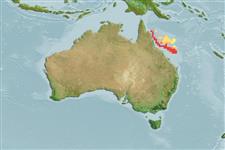分類 / Names
俗名 | 同種異名 | Catalog of Fishes(屬, 種) | ITIS | CoL | WoRMS | Cloffa
Elasmobranchii
板鰓亞綱 (鯊魚與魟魚) (sharks and rays) >
Rajiformes (Skates and rays)
鰩目 (Skates and rays) >
Rajidae (Skates)
鰩科 (Skates)
Etymology: Dipturus: Greek, di = two + Greek, pteryx = fin (Ref. 45335); apricus: Name from Latin 'apricus' meaning exposed to the sun, in cryptic reference to its common name..
More on authors: Last, White & Pogonoski.
Environment: milieu / climate zone / depth range / distribution range
生態學
海洋 居於水底的; 深度上下限 196 - 606 m (Ref. 75649), usually 300 - 500 m (Ref. 75649). ; 14°S - 21°S, 145°E - 153°E (Ref. 114953)
Western Central Pacific: off Queensland, Australia.
大小 / 重量 / 年齡
Maturity: Lm ? range ? - ? cm
Max length : 65.9 cm TL 雄魚/尚未辨別雌雄; (Ref. 75649); 76.5 cm TL (female)
Inhabits outer continental shelf and upper slope. Probably feeds on small bony fishes (Ref. 114953). Observed lengths of adolescent males between ca. 47.0 (tail tip damaged) and 64.4 cm TL, smallest juvenile 15.0 cm TL (Ref. 75649) to 17 cm TL (Ref. 114953).
Life cycle and mating behavior
Maturities | 繁殖 | Spawnings | Egg(s) | Fecundities | 仔魚
Last, P.R., W.T. White and J.J. Pogonoski, 2008. New skates of the genus Dipturus (Rajoidei: Rajidae) from Australian Seas. pp. 9-52. In Last, P.R., W.T. White, J.J. Pogonoski and D.C. Gledhill (eds.): Descriptions of new Australian skates (Batoidea: Rajoidei) pg. 9-51. CSIRO marine and atmospheric reseach paper no. 021. (Ref. 75649)
人類使用
工具
特別的報告
下載 XML
網路資源
Estimates based on models
Preferred temperature (Ref.
123201): 9.3 - 17.3, mean 13.3 °C (based on 41 cells).
Phylogenetic diversity index (Ref.
82804): PD
50 = 0.5000 [Uniqueness, from 0.5 = low to 2.0 = high].
Bayesian length-weight: a=0.00282 (0.00133 - 0.00596), b=3.25 (3.08 - 3.42), in cm total length, based on LWR estimates for this Genus-body shape (Ref.
93245).
營養階層 (Ref.
69278): 3.8 ±0.6 se; based on size and trophs of closest relatives
回復力 (Ref.
120179): 低的, 最小族群倍增時間4.5 - 14 年 (Preliminary low fecundity).
Fishing Vulnerability (Ref.
59153): Moderate to high vulnerability (51 of 100).
